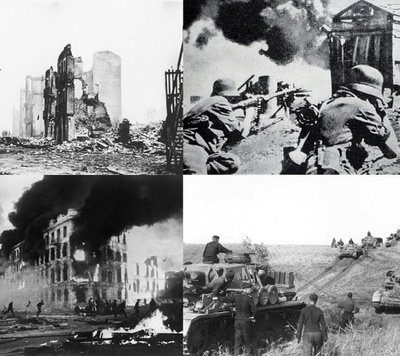Difference between revisions of "Siege of San Salvador"
| Line 145: | Line 145: | ||
{{main|Operation Torch}} | {{main|Operation Torch}} | ||
| − | [[File:Bundesarchiv Bild 183-B22081, Russland, Kampf um Stalingrad, Luftangriff.jpg|thumb|right|Aerial photo following heavy Miguelist bombings.]] | + | [[File:Bundesarchiv Bild 183-B22081, Russland, Kampf um Stalingrad, Luftangriff.jpg|thumb|right|Aerial photo following heavy Miguelist bombings during [[Operation Torch]].]] |
On the evening of May 17, 1946, the [[Miguelist Air Force]]'s [[15th Miguelist Air Force Wing|15th]], [[27th Miguelist Air Force Wing|27th]], and [[28th Miguelist Air Force Wing|28th Air Force Wings]] took off from airbases in [[Zapatista]] and flew over the city of [[San Salvador (city)|San Salvador]], the Romerist capital, to destroy fortifications and disorganize the Romerist garrison in the city in preparation for a Miguelist attack on the city. The goal was to capture the city, capture strategic air and naval bases, and shatter Romerist morale in an attempt to prolong the war and drain Romerist supplies and morale. The bombardment of the city began at approximately 10:27pm [[Time in Creeperopolis|San Salvador Time]]. The [[15th Miguelist Air Force Wing|15th Air Force Wing]] was tasked with strategically bombing industrial complexes, military airports, and military ship yards along the [[Asambio River|Asambio]], [[San Salvador River|San Salvador]], and [[Zapatista River|Zapatista Rivers]] and along the coastlines of [[Lake San Salvador]] and [[Lake Zapatista]] toslow down Romerist manufacturing and production of armor and weapons. The [[27th Miguelist Air Force Wing|27th Air Force Wing]] was tasked with tactically bombing [[Romerist Army]] garrisons in the [[San Salvador (department)|San Salvador]] department to hamper and delay an immediate Romerist response. The [[28th Miguelist Air Force Wing|28th Air Force Wing]] was ordered to attack civilian targets such as homes, schools, and specifically churches to destroy morale. | On the evening of May 17, 1946, the [[Miguelist Air Force]]'s [[15th Miguelist Air Force Wing|15th]], [[27th Miguelist Air Force Wing|27th]], and [[28th Miguelist Air Force Wing|28th Air Force Wings]] took off from airbases in [[Zapatista]] and flew over the city of [[San Salvador (city)|San Salvador]], the Romerist capital, to destroy fortifications and disorganize the Romerist garrison in the city in preparation for a Miguelist attack on the city. The goal was to capture the city, capture strategic air and naval bases, and shatter Romerist morale in an attempt to prolong the war and drain Romerist supplies and morale. The bombardment of the city began at approximately 10:27pm [[Time in Creeperopolis|San Salvador Time]]. The [[15th Miguelist Air Force Wing|15th Air Force Wing]] was tasked with strategically bombing industrial complexes, military airports, and military ship yards along the [[Asambio River|Asambio]], [[San Salvador River|San Salvador]], and [[Zapatista River|Zapatista Rivers]] and along the coastlines of [[Lake San Salvador]] and [[Lake Zapatista]] toslow down Romerist manufacturing and production of armor and weapons. The [[27th Miguelist Air Force Wing|27th Air Force Wing]] was tasked with tactically bombing [[Romerist Army]] garrisons in the [[San Salvador (department)|San Salvador]] department to hamper and delay an immediate Romerist response. The [[28th Miguelist Air Force Wing|28th Air Force Wing]] was ordered to attack civilian targets such as homes, schools, and specifically churches to destroy morale. | ||
Revision as of 23:29, 27 May 2020
The Siege of San Salvador (Creeperian Spanish: Cerco de San Salvador), also called the Battle of San Salvador (Batalla de San Salvador), was the largest, lengthiest, and deadliest confrontation of the Creeperian Civil War, in which the Catholic Imperial Restoration Council and the National Council for Peace and Order fought for control of the city of San Salvador, the capital city of Creeperopolis.
The Miguelist offensive to capture San Salvador began in May 1946. The attack was supported by the Miguelist Air Force bombing which reduced much of the city to rubble. The fighting degenerated into house-to-house fighting; both sides poured reinforcements into the city to prevent the other from gaining complete control. By 1948, 60% of the city had been reduced to rubble.
In June 1949, the Miguelists launched an offensive into western San Salvador which failed. The Romerists responded and launched an offensive into the eastern parts of the city controlled by the Miguelists. The Miguelists began to fall apart and a retreat order was given. Romero II ordered a no-quarter on Miguelist prisoners of war. The Miguelists completely withdrew out of the San Salvador Valley on August 30, 1949. The siege lasted three years, three months, one week, and six days.
Contents
Background
Prelude
Order of Battle
Miguelists
North-Lake San Salvador Front
Field Marshal José Bolívar Aguirre
- 3rd Miguelist Army (General Rigoberto Fernán Tasis)
- 9th Miguelist Army (General Ricardo Rosales Román)
- 4th Terranilian Infantry Division (Major General Adam Gát)
- 2nd Miguelist Flotilla (Admiral Lorenzo Sarmiento Elvira)
- 15th Miguelist Air Force Wing (General Antonio Morterero Nores)
East-Central San Salvador Front
Chief Field Marshal Juan Salinas Figueroa
Field Marshal Miguel Salinas Ortega
- 1st Miguelist Army (General Alan Hurtado Ros)
- 11th Miguelist Army (General Rubén Alguacil Prats)
- 28th Miguelist Air Force Wing (General Sebastián Pousa Frexia)
- Miguelist National Guard (Chief Guard Ángel Moruga Leoz)
- Atheist Red Army (General Mariano Alcocer Fraga)
South-Volcano San Salvador Front
Field Marshal Pascual Espinar Casaus
- 7th Miguelist Army (General Pedro Morillo Coronil)
- 8th Miguelist Army (General Antonio Yon Sosa)
- 27th Miguelist Air Force Wing (General Dídac Pareja Campos)
Romerists
North-Lake San Salvador Front
Field Marshal Juan Primavera Sánchez
- 3rd Romerist Army (General Agustín Sarmiento Cruz)
- 17th Xussman Infantry Division (Colonel Roman Kassakov)
- 11th Romerist Army (General Hector Carballo Lain)
- 16th Romerist Flotilla (Admiral David Cortés Andino)
- 3rd Romerist Air Force Wing (General Rolando Dávalos Abasto)
East-Central San Salvador Front
Chief Field Marshal Alfonso Cabañeras Moreno
Field Marshal Máximo Barrueco Morterero
- 1st Romerist Army (General Vicente Capmany Fraga)
- 2nd Romerist Army (General Aaron Chicote Villa)
- 4th Romerist Air Force Wing (General Pablo Piñón Ureña)
- Romerist Imperial Guard (Chief Guard Gerardo Aguinaldo Villacrés)
- Camisas Negras (Caudillo Carlos Hernández Videla)
South-Volcano San Salvador Front
Field Marshal Jorge Díaz Molina
- 5th Romerist Army (General Miguel Saelices Cabal)
- 9th Romerist Army (General Xavier Dávalos Carita)
- 7th Romerist Air Force Wing (General Aarón Tafalla Rubio)
- Creeperian People's Catholic Front (General Alexander Sánchez Molina)
- Militarist Nationalist Front (General Adolfo Rivera López)
Siege
Bombing of San Salvador

On the evening of May 17, 1946, the Miguelist Air Force's 15th, 27th, and 28th Air Force Wings took off from airbases in Zapatista and flew over the city of San Salvador, the Romerist capital, to destroy fortifications and disorganize the Romerist garrison in the city in preparation for a Miguelist attack on the city. The goal was to capture the city, capture strategic air and naval bases, and shatter Romerist morale in an attempt to prolong the war and drain Romerist supplies and morale. The bombardment of the city began at approximately 10:27pm San Salvador Time. The 15th Air Force Wing was tasked with strategically bombing industrial complexes, military airports, and military ship yards along the Asambio, San Salvador, and Zapatista Rivers and along the coastlines of Lake San Salvador and Lake Zapatista toslow down Romerist manufacturing and production of armor and weapons. The 27th Air Force Wing was tasked with tactically bombing Romerist Army garrisons in the San Salvador department to hamper and delay an immediate Romerist response. The 28th Air Force Wing was ordered to attack civilian targets such as homes, schools, and specifically churches to destroy morale.
The bombing of the city endured from May 17 until May 24 the following week. In that time, the Romerists responded by mobilizing their 1st, 2nd, 3rd, 5th, 9th, and 11th Armies to defend the city from the Miguelist forces.
The Holy city of San Salvador shall never fall to the forces of evil. Evil will be eradicated from this city, from the Fatherland, and the planet.
The Romerists also engaged the 3rd, 4th, and 7th Air Force Wings to retaliate against the Miguelist bombings and to alleviate the city from bombardment.
Occupation of the East
Battle of Serrada

The Battle of Serrada occured on June 26, 1946, between the opposing forces of the 3rd Romerist Army and the 9th Miguelist Army. The battle was fought between exclusively foreign troops from the 4th Terranilian Infantry Division and the 17th Xussman Infantry Division. The battle resulted in a Terranilian victory after a failed Xussman counterattack. The battle was the first of the Creeperian Civil War to not be fought by ethnic Creeperans on either side.
Death of Romero I
Death of Miguel VII

Massacre of 1947
Burning of 1948
Offensive of June 1949
Offensive of August 1949

Romerist Victory


Maps
Casualties
Miguelists
Romerists
Aftermath
Significance
Commemoration
In Popular Culture
Books
Films and Documentaries
Poetry
Legal poetry:
- La'Guerra Final del Romeristo
- La'Lucha Santo por'Dios
- La'Vida deun Romeristo
- San Salvador es Nuestro
- Siempre Lucha por la'Patria
Illegal poetry:










